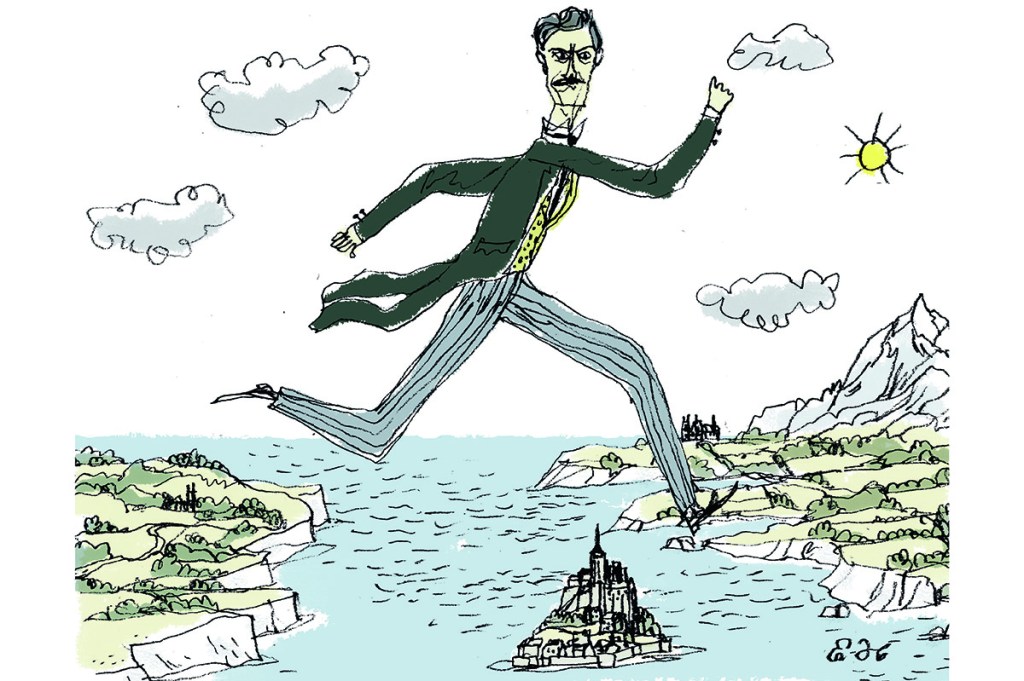Kudos to Masterpiece’s new eight-part series Around the World in 80 Days, if only for nudging me to read Jules Verne’s original tale of an eccentric Englishman who sets out from London in 1872 on a strict deadline to girdle the globe, as well as to revisit Michael Todd’s Oscar-winning 1956 movie version.
Bad translations and Disney movies long consigned much of Verne’s prodigious output to the realm of juvenile entertainment, in the popular mind anyway. Serious critics tell us that we should think again — that in a novel like Around the World in Eighty Days (1873) there is indeed a lot going on. The character of Phileas Fogg has layers beneath his serene reserve, as his passage around the world begins to reveal. But it is less the man — Fogg, the sort who “might live on a thousand years without growing old” — than his journey that keeps Around the World rolling, a century-and-a-half later and counting.
The story is fiction. The world it illuminates is fact. It begins with a conversation among members of London’s Reform Club about how two new continental railways (across India and America) and the Suez Canal were shrinking the world, or at least the time required to circumnavigate it, to no more than eighty days. This was the age when the speed of overland transportation increased by a factor of ten, from five miles per hour on horseback to fifty miles per hour by train. Iron steamships that could navigate in relatively straight lines made possible reliable schedules and faster sea voyages. Submarine cables brought speed-of-light communications.
None of this led — not yet anyway — to mass tourism, but it was now possible to plan great journeys with some assurance that one would arrive at one’s destination safely, and in a timely manner. All it took was leisure and money, and Phileas Fogg has plenty of both. He leaves London immediately upon placing the wager, carrying a carpetbag containing £20,000 for the journey, or about £2.5 million today.
What follows is an eastbound romp across three continents and as many oceans and back to London in time to win the wager (for £20,000, on account at Barings and the other half of Fogg’s fortune), with seconds to spare. It is a land journey traversing Eurasia and North America, largely by rail. It is also a series of sea voyages, on steamers with names like Mongolia, Rangoon, Carnatic, General Grant and China. In the movie and on Masterpiece, but not in the book, there is even a taste of air travel: a balloon ride from Paris to somewhere in Spain in the movie, or somewhere in Italy on Masterpiece.
Fogg keeps company throughout, traveling with his manservant, Passepartout, in all three versions. In India, in the book and the movie, they are joined by a princess rescued from the funeral pyre of her rajah husband. On Masterpiece, there is no princess; instead we get a pretty and pushy female journalist who attaches herself from the beginning, determined to report on the journey for the Daily Telegraph, which her father owns. Two boys, one girl for the duration. A romantic narrative ensues in all versions of the story. In the book and the movie, it is Fogg and Aouda, the Indian princess, who at journey’s end tumble into marriage. On Masterpiece, the spark strikes between the journalist, Abigail “Fix” Fortescue, and Passepartout. As of episode six, it is unclear how far this goes.
Along the way, obstacles must be overcome as delays disrupt the schedule. The clock is ticking. Verne had it that the mysterious Fogg was actually a robber on the lam: he’d lifted £55,000 from the Bank of England and was using the ruse of the wager to abscond to some far place beyond the arm of the law. Scotland Yard’s Inspector Fix (played hilariously in the film by Robert Newton, of Long John Silver fame) sticks doggedly to his man but requires a warrant from London to make the arrest, which he must do before Fogg leaves Hong Kong, the last British territory on the itinerary. On Masterpiece, Fogg is pursued by a darker villain hired by a disloyal friend and fellow Reform Club member who must win the wager or face financial ruin.
Agents of delay either way: Fogg must be stopped. But the adventurer is a determined, resourceful and lucky fellow. He confounds his pursuers, typhoons, Indian attacks and collapsing bridges to do what he set out to do. Until the Masterpiece version, Fogg is the benign imperialist who knows when to command, when to stand aside and let the natives have their way. In all versions, it should be noted, he travels courtesy Pax Britannica, which made much of the world safe for such adventures.
The 1956 movie starred David Niven at his zenith as Fogg, Mexican superstar Cantinflas as Passepartout and a bevy of marquee names in cameos, from Gielgud to Dietrich to Sinatra. Nor can we forget Victor Young’s majestic score. The film feels innocent, joyful even, but not juvenile, and it never fails to hold the eye. It was made for the big screen and loses much on a small one. It belongs to the grand-spectacle era of moviemaking, which coincided with the closing days of travel-poster travel, when most people in the audience could only dream of visiting such exotic places and swooned at the very thought of it. A little “bar” in the basement of my boyhood home was festooned with such artifacts: “See London, Paris, Rome, Hong Kong with TWA.”
The new Masterpiece version, which features fine performances by David Tennant as Fogg, Ibrahim Koma as Passepartout and Leonie Benesch as Abigail, betrays a different sensibility entirely, one fit for emotive, therapeutic times like ours. By this I mean it is not the journey that drives us from episode to episode, but rather the relationships among the trio — relationships that could have played out anywhere. The Indian episode illustrates the difference. The movie gives us an elephant ride through the bush, where our travelers come upon a brutal indigenous ritual and Fogg rescues the young woman about to be burned alive. The action plays out not as heroics but simply as Victorian duty done. Pax Britannica trumps suttee: viewers may cheer. Masterpiece dispenses with the princess in distress and instead takes us to a local village where a sepoy, who has gone AWOL in order to marry the girl he loves, is pursued by a heartless British officer — heartless, that is, until won over by a sensitive Fogg. Britain’s Raj was wicked, or at least highly “problematic”: viewers may feel absolved.
These pitches to progressive pieties damage the story and will date easily. They also pile up, to the point where backstory drowns out journey, which is what Around the World is all about. Yes, Verne and Niven’s singleminded Fogg, with his head in a timetable and valise full of banknotes, seldom looks up at the scenery. Yet Verne’s account could not but help reveal great swaths of the world as few Westerners had seen it. This was, and is, both edifying and fun. The book and the movie take us out of the neighborhood and out of ourselves. We’re traveling. The new Masterpiece telling only draws us into the angst of its refurbished characters. We’re stuck.
It’s possible, of course, that the producers are just stretching things out to save material for a second season — but they risk a stall. Who knows: will our tastefully diverse, trying-to-get-along team go around again, westward this time? If you’re in it for the relationships, it doesn’t matter — this Around the World is for you. If you’re an armchair traveler, best forget it. Stick with the movie, or maybe even read the book.
This article was originally published in The Spectator’s May 2022 World edition.

























